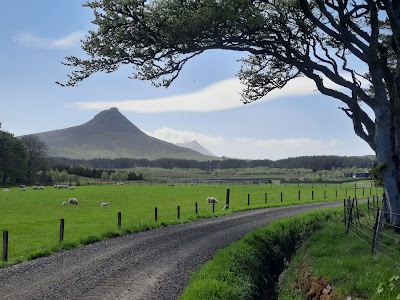I always thought Caithness was a flat county, beyond the hills. Morven, Scaraben, and Maiden Pap beg to differ.
Maiden Pap must be one of the most distinctive small hills in the country, yet it is virtually unknown.
From some angles it looks like the Roseberry Topping of Caithness (which itself is the 'Matterhorn of Yorkshire').

From other angles it lives up to its name, an improbably pert breast. It just fails to reach 500m, but you would not get tired of looking at this peak.
But I was not here for Maiden Pap. I was here to climb Morven, at 706m the county top of Caithness. Hidden behind Maiden Pap, it slowly reveals itself as you travel the estate track from Braemore. In a backlit headwind, it looked much higher and further away than it actually is.
After the track I took to moorland bashing, glad of the sunshine and clear skies despite the powerful headwind.
Finally I found myself at the base of Morven and the 400m pull up the summit cone. There are two ways up, both awkward. One involves a trackless traverse round the mountain to find a steep grassy gully that pops out just below Morven's east top. The second tackles the hill direct, but peters out into an unpleasantly steep and loose boulderfield, before also popping out at the east top. I started the traverse and enjoyed a moment out of the wind, sheltered behind the steep bulk of Morven. A rush of wind like a mighty river in the corrie below.

A cuckoo was calling. But where were the trees?
Higher up a lizard slinked out my way, before I breached the final steepening and the summit cone. The wind tore at me as I staggered to the summit, bright superstreams of light-saturated air. An intense and happy moment before starting the descent.
With the wind at my back and going down, the walk back along the moor, which earlier had been such a trudge, seemed effortless. Marching across the bog and singing at the top of my voice, I suddenly came across this foot-long snake:
An adder! I doubled back to take another photo and it coiled and faced me as if about to strike. Nope nope nope! I beat a retreat and decided not to bivvy out here tonight. But I had been up Morven, my penultimate county top.
Maiden Pap from the west:
I started bagging county tops in the lockdown, when we weren't allowed out our own county and I realised I hadn't been up its highest point. Now only Rona's Hill in Shetland is left to visit for my completion.

















